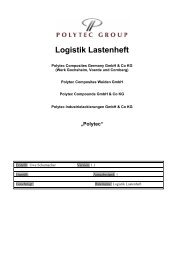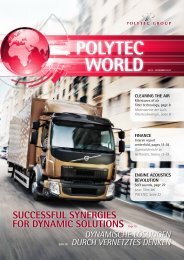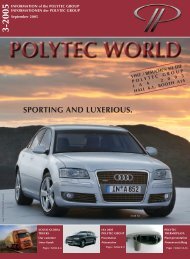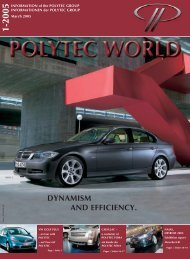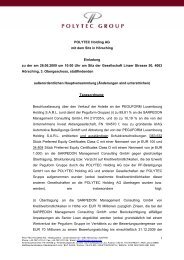A rePort: How is a head- liner actually produced? friedrich ... - polytec
A rePort: How is a head- liner actually produced? friedrich ... - polytec
A rePort: How is a head- liner actually produced? friedrich ... - polytec
You also want an ePaper? Increase the reach of your titles
YUMPU automatically turns print PDFs into web optimized ePapers that Google loves.
58<br />
3. Tangible Assets<br />
Tangible assets are valued at the costs of acqu<strong>is</strong>ition or manufacturing,<br />
less the scheduled depreciation or the lower recoverable<br />
fair market value. Scheduled depreciation <strong>is</strong> determined according<br />
to the straight-line method.<br />
For consumable tangible assets, the following rates of scheduled<br />
depreciation are used:<br />
IN %<br />
Buildings and leasehold improvements 4.0 – 20.0<br />
Technical equipment and machinery<br />
Other equipment, fi xtures,<br />
6.7 – 50.0<br />
fi ttings and equipment 10.0 – 50.0<br />
Low value items 100.0<br />
Impairment losses exceeding the scheduled depreciation are<br />
taken into account by extraordinary depreciation. If the reason for<br />
an extraordinary depreciation ceases to ex<strong>is</strong>t, a respective writeup<br />
will be carried out.<br />
If tangible assets are closed down, d<strong>is</strong>posed of or abandoned, the<br />
resulting profi t or loss from the difference between the sales revenues<br />
and the remaining book value are recorded as other operating<br />
income or expenditure.<br />
Maintenance expenses are reported as expenses in the fi nancial<br />
year of their occurrence.<br />
Interest on borrowed capital for tangible assets are not capital<strong>is</strong>ed<br />
if their production or acqu<strong>is</strong>ition compr<strong>is</strong>es a longer period<br />
of time.<br />
4. Leased Tangible Assets<br />
In line with IAS 17, leased tangible assets for which all essential<br />
r<strong>is</strong>ks and opportunities resulting from the ownership of such asset<br />
have been transferred (fi nance lease) are valued at their market<br />
value or the lower present value. Such assets are depreciated over<br />
the useful life of the asset or the shorter term of the lease contract.<br />
Payment obligations resulting form future lease instalments are<br />
d<strong>is</strong>counted and reported under liabilities.<br />
5. Government Grants<br />
Government grants are recorded under liabilities and liquidated in<br />
accordance with the useful life of the allocated asset.<br />
6. Financial Assets<br />
Other investments and loans are included under Other fi nancial<br />
assets. The are valued at the costs of acqu<strong>is</strong>ition or the lower<br />
market value as of the balance sheet date. Interest-bearing loans<br />
are d<strong>is</strong>closed in the balance sheet at their nominal value.<br />
POLYTEC<br />
ANNUAL REPORT 2006<br />
NOTES<br />
The investments d<strong>is</strong>closed in the balance sheet at their costs of<br />
acqu<strong>is</strong>ition are investments not l<strong>is</strong>ted at an active market and<br />
whose current value can, therefore, not be determined in a reliable<br />
manner.<br />
Loans are subject to variable interest rates so that their book value<br />
corresponds approximately to their market value.<br />
All fi nancial assets are extraordinarily depreciated if an impairment<br />
of value occurs (see the note on impairment of assets in<br />
the Notes).<br />
7. Inventories<br />
Inventories are valued at the costs of acqu<strong>is</strong>ition or manufacturing<br />
or at the lower recoverable market value as of the balance sheet<br />
date. The acqu<strong>is</strong>ition and manufacturing costs for similar assets<br />
are determined by applying the weighted average price method<br />
or similar methods. Manufacturing costs include only directly allocated<br />
expenses and pro-rata over<strong>head</strong>s. Interests for borrowed<br />
capital are not capital<strong>is</strong>ed.<br />
8. Trade Accounts Receivables<br />
and other Receivables<br />
Trade accounts receivables and other receivables are capital<strong>is</strong>ed<br />
at costs of acqu<strong>is</strong>ition. Recogn<strong>is</strong>able r<strong>is</strong>ks are refl ected by forming<br />
appropriate valuation adjustments.<br />
9. Cash and Cash Equivalents<br />
Cash and other short-time fi nancial means cons<strong>is</strong>t of cash on<br />
hand, cheques and cash at banks as well as securities and are<br />
valued at their market value.<br />
10. Impairment of Assets<br />
Assets are tested at the balance sheet date if any indications ex<strong>is</strong>t<br />
for an impairment. Such an annual verifi cation (impairment test)<br />
<strong>is</strong> made for goodwill shortly prior to each balance sheet date,<br />
regardless if any indications of impairment ex<strong>is</strong>t.<br />
For the purpose of the impairment test, POLYTEC GROUP combines<br />
all assets allocated to the smallest cash-generating level<br />
(cash-generating unit). Goodwill <strong>is</strong> allocated to those cash-generating<br />
units from which a synergy real<strong>is</strong>ation <strong>is</strong> expected and which<br />
represent the smallest unit subjected to the management’s superv<strong>is</strong>ion<br />
of cash fl ows.<br />
The value in use of the asset corresponds to the present value<br />
of the estimated future cash fl ows from continuing use of such<br />
asset and from its d<strong>is</strong>posal at the end of its useful life by applying<br />
a fair market d<strong>is</strong>count rate before taxes which <strong>is</strong> adjusted to the<br />
specifi c r<strong>is</strong>ks of the assets. The d<strong>is</strong>count rate used for calculating<br />
the present value represents the weighted average cost of capital<br />
of the group and <strong>is</strong> fi xed with 8% for the fi nancial year 2006 (2005:



